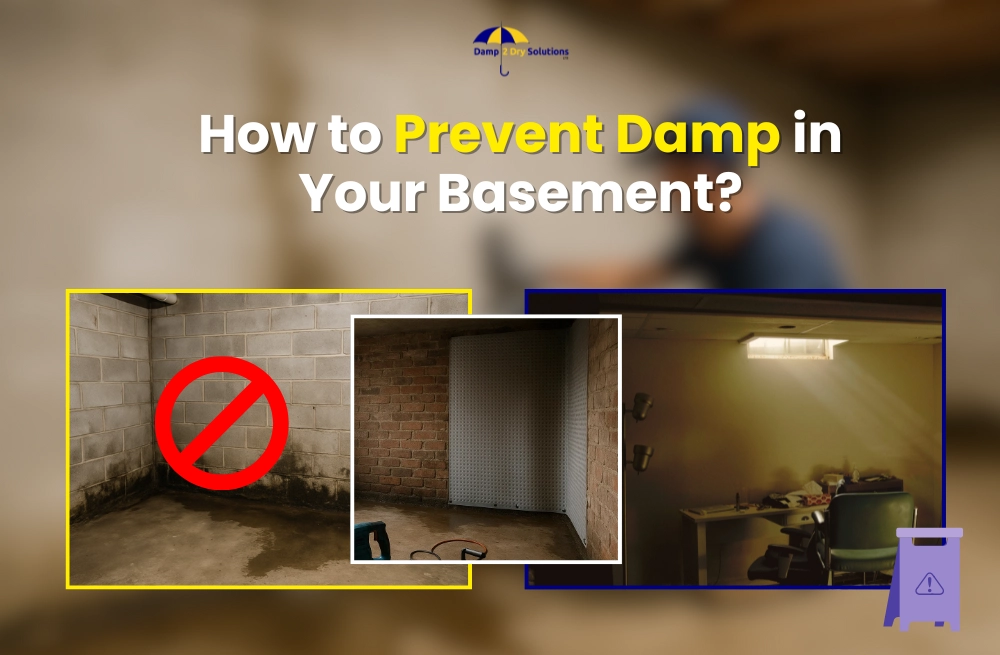
A blog from the specialists at Damp-solutions of Cheshire, helping homeowners protect their property from moisture, mould, and damage for the last 20+ years.
Basement damp might start as a musty smell or a few dark patches on the wall. But if you leave it unchecked, it can cost you thousands in house repairs.
In fact, according to the Damp Proofing Association UK, misdiagnosed issues like condensation and poor ventilation lead to unnecessary treatments, costing British households over £200 million each year.
Be it water seeping through wall when it rains or trapped humidity feeding hidden mould, moisture can spread quickly if left unattended. Worse, it turns what could be a useful living or storage space into a wasted, unusable area beneath your home.
With the right mix of drainage, ventilation, and basement damp proofing, you can protect your home’s structure, air quality, and long-term value. In this blog, we’ll discuss the proven way of preventing damp in your basement and thus, saving you tonnes of money every year.
Keep reading!
What Causes Basement Damp?
In most Yorkshire homes, basement damp comes down to three things —
- Poor airflow,
- Outside water getting in,
- Or a hidden leak
In your cold basement walls, if warm and damp settle pretty often, it can cause condensation and mould. At times, the rainwater also comes through the tiny gaps you may have in the brickwork of your basement floor. Not to forget, small leaks from an old pipe behind the wall can also cause damp in your basement.
You’ll usually spot it by a musty smell, peeling paint, or damp patches near the floor. If you notice any of these, call for a quick basement leak repair, because it’s the easiest way to stop the problem before it spreads.
Now that you know the likely cause, here’s exactly what to do step by step to keep the basement dry all year:
Step 1: Improve Ventilation and Control Condensation
Good airflow can alone do a lot in keeping your basement dry. Fit extractor fans or a few wall vents to move damp air out because it’s the simplest fix. Under cellar ventilation UK guidance, place the vents at different heights so air can actually move around, not just sit in corners.
If one side of the room always feels clammy, drop in a basement moisture absorber or a small dehumidifier. On dry days, crack open the door or window and let the space breathe a bit. And if your pipes or walls feel cold to the touch, wrap or insulate them, as that’s where condensation starts.
A small positive-pressure fan can also help; it pushes fresh air in and the stale, wet air out. Keep an eye on humidity (anything under 60% is fine). Do that, and you’ll never have that heavy, musty smell again.
Step 2: Fix External Water Problems First
Most damp starts outside before it ever shows up indoors.
Make sure rainwater runs away from your walls, not towards them. Start with the basics: clean the gutters twice a year and fit downspouts that carry water at least four to six feet clear of the foundations. If the ground slopes toward the house, build it up so it falls away.
In yards that stay soggy, add a French drain or simple land drain to move the water off faster. Look over the brickwork for hairline cracks and seal them before winter. It’s often the easiest damp basement floor solution you can make.
Keeping surface water in check is the backbone of all basement waterproof methods; stop it outside, and you’ll never fight it inside.
It’s safe to say that keeping water out in the first place is far cheaper than pumping it out later.
Step 3 – Seal Cracks and Waterproof Interior Walls
Even the tiniest cracks or weak plaster joints can let the moisture in. You’ll be seeing damp spots later on your wall. The best approach is to seal everything properly and build up waterproof layers that block water at every stage.
Here’s how to do it right:
| Action | What to Do | Why It Helps |
|---|---|---|
| Seal cracks with epoxy or flexible sealant | Fill small masonry or floor cracks so moisture can’t creep through. | Quick, low-cost fix that stops early seepage before it spreads. |
| Apply waterproof coating (tanking) | Use masonry paint or a cement-based slurry; apply two or three even coats for full coverage. | Creates a watertight barrier on interior walls and floors. |
| Add waterproof membranes | Fit plastic or bitumen sheets behind wall finishes or floors. | Keeps water in basement from pushing through under pressure. |
| Clean surfaces first | Remove flaking paint and white salt deposits before sealing. | Ensures coatings and sealants adhere properly and last longer. |
| Combine methods if needed | Seal → coat → membrane for persistent damp problems. | Most reliable way to damp proof a basement from the inside and protect it long-term. |
Once the cracks are sealed and coatings have cured, your basement walls will finally have a proper moisture barrier. The next step is to look at professional waterproofing systems because these give you extra peace of mind when damp problems are recurring or structural.
Step 4 – Consider Professional Waterproofing Systems
If your damp problem keeps coming back, it’s time to bring in the experts. But before choosing one, talk to damp specialists who can assess the property and tell you exactly how to deal with damp in your basement.
| System Type | What It Involves | Best For |
|---|---|---|
| Type A – Barrier Protection (Tanking) | A waterproof coating or slurry applied to the inside of basement walls and floors. | Ideal for mild to moderate damp where water pressure is low. |
| Type B – Integral Protection | Uses waterproof concrete or built-in additives during construction to form an all-in-one barrier. | Best suited for new builds or full structural renovations. |
| Type C – Drained Protection (Cavity Drainage System) | Installs studded plastic membranes that guide moisture into hidden channels and a sump pump for discharge. | Reliable long-term fix for heavy or persistent damp problems. |
Professional advice: Only certified contractors can correctly design and install these systems. A full damp survey ensures the right choice and provides warranties that last 20–30 years.
Even if the work feels like a bigger investment now, proper basement damp proofing saves major repair costs later and adds real value to your property. Once the system is in place, you’ll notice the difference, i.e., no musty odours, no peeling paint, just a clean, dry basement ready for use.
Step 5 – Maintain a Dry, Healthy Basement
A few quick checks through the year, and you’ll stop small issues from becoming bigger jobs:
- Inspect regularly: Every few months, look over the walls and floor for new cracks, stains or signs of mould.
- After heavy rain: Quickly wipe and disinfect the area. It will help damp from settling in.
- Keep air moving: Leave a bit of space behind stored items for better ventilation to the basement.
- Protect belongings: Raise boxes or furniture off the ground to avoid any damage from a damp cellar floor.
- Service equipment: Run the sump pump once a year to be sure it’s working.
- Track humidity: You just need a cheap hygrometer. Aim to keep it between 45 % and 60 %.
- Gutters and downspouts: Clear them at least twice a year; it’s still the easiest and cheapest damp-proofing there is.
Do these little things now, and you won’t be paying for repairs later. Most basements that stay dry are just the ones people keep an eye on.
What’s the Cost of Basement Damp Proofing in the UK?
The seriousness of the problem and the method you choose are two direct reasons for how much the cost of basement damp proofing in UK be in your home. Small repairs need a quick reseal, but complete waterproofing is, of course, costly because it means more time, materials, and labour.
Here’s a clear breakdown of what homeowners can expect to pay in 2025:
| Service | Typical Cost Range | Notes |
|---|---|---|
| Minor damp-proofing repair | £200 – £500 | Patch membranes or reseal coatings. |
| Full damp-proof conversion | £1,200 – £3,000 | For small to medium basements. |
| Structural waterproofing/tanking | £3,000 – £18,000+ | Depends on size, system, and access. |
| Average per m² | £40 – £250 | National UK average cost range. |
Additional costs to not forget:
- Dehumidifier hire (£65–£85/week)
- Survey (£100–£200)
- Waterproof sealers (£25–£85 per 5 L)
Investing in proper waterproofing will save you far more than spending money to fix the recurring leaks or mould damage. Always remember to reduce humidity in your basement with good airflow and insulation. This way, your new waterproofing will last for many years to come.
Also Read: Top Signs Your Basement Needs Waterproofing
When to Call the Professionals?
Preventing basement damp isn’t about a single fix.
You have to keep the air moving, manage water outside, and protect the walls from within. With good drainage, proper basement insulation, and regular checks, most homeowners can keep their space dry without much trouble.
But if you still see leaks persistently, have cracks in the structure, or experience that damp basement smell, it’s better to call in the experts. A professional survey done by them will help find out the reason for the damp and recommend the right way of treating it. Whichever treatment is done, it will all be backed by long-term warranties.
At Damp Solutions, we help homeowners prevent mould & damp for good. We’ll turn your cellar into a dry and usable room. You’ll be able to add real value to your property and peace of mind with our basement conversion service. Before you do that, we recommend you book an independent damp survey today to find out what’s really causing damp in your home.
Note: Dial 01606-872-691 to book your damp survey faster.
FAQs on Basement Damp Prevention
Do I need planning permission?
No, unless you are turning your basement into a habitable place. In that case, you’ll have to keep in mind the building regulations for cellar ventilation, insulation, and fire safety. A damp surveyor can advise before you start any conversion work.
Can I DIY damp-proof my basement?
Yes, you can. You can seal small cracks and apply basic coating yourself. However, you’ll need qualified contractors for full waterproofing jobs like tanking or installing membranes. If there is stubborn condensation mould, you can install the best basement dehumidifiers until there is a proper professional fix.
How long does damp-proofing last?
Usually 20-30 years. But a well-installed waterproofing can last longer than that. Do regular checks, clear gutters, and keep good airflow to reduce humidity in your basement. This will extend the life of your damp-proofing work.
What’s the best humidity level for a basement?
Humidity levels between 45% and 60% are fine. Anything higher than that makes perfect conditions for mould or musty damp basement smell. If the readings always stay above this range, look into the drainage or airflow solutions and stop moisture in basement floors before it affects other areas in your home.

